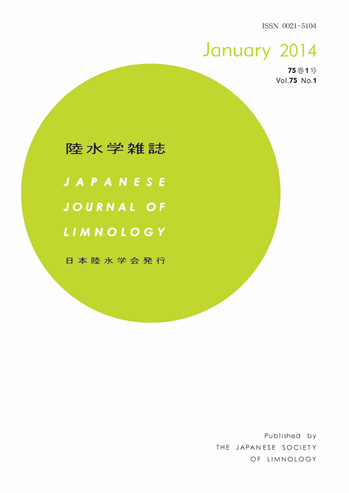All issues

Volume 75, Issue 1
Displaying 1-4 of 4 articles from this issue
- |<
- <
- 1
- >
- >|
Original article
-
Koki ONISHI, Shin-ichi ONODERA, Mitsuyo SAITO, Yuta SHIMIZU, Masashi Y ...2012 Volume 75 Issue 1 Pages 1-11
Published: September 08, 2012
Released on J-STAGE: February 25, 2015
JOURNAL FREE ACCESSSpatial distribution characteristics of nitrous oxide (N2O) in an unconfined aquifer were examined, based on changes in concentrations of N2O, nitrate-nitrogen (NO3 --N) and other chemical components with the groundwater flow of an agricultural catchment affected by significant fertilizer application. N2O concentrations were about 4μgN L-1 in the upstream area, and were positively correlated with NO3 --N concentrations. These results suggest that the nitrification process influences N2O concentrations in upstream areas. In the downstream area, N2O concentrations in deeper groundwater (> 15 m) were significantly higher (13 μgN L-1), but they were very low in shallower groundwater (< 15 m), below the detection limit. Spatial distributions of dissolved oxygen (DO) and dissolved organic carbon (DOC) suggest that shallower groundwater is characterized by a strong reducing condition and high organic carbon content compared to deeper groundwater. These results suggest that a complete denitrification process (NO3 -→N2) occurs in shallower groundwater, whereas an incomplete denitrification process causes the increase of N2O concentrations found in deeper groundwater.View full abstractDownload PDF (1255K) -
Goro NIGI, Shinji FUJITA, Kensaku AZUMA, Hiroyuki HIRAGA2013 Volume 75 Issue 1 Pages 13-26
Published: July 10, 2013
Released on J-STAGE: February 25, 2015
JOURNAL FREE ACCESSTo understand the change in runoff characteristics of turbid water generated by the large-scale landslides that occurred in the upstream areas of the Monobe River in August 2004 and September 2005, the period 2001~2011 was assessed. Data analyzed included the secular variation of the SPM (suspended particulate matter) load, the correlation between discharge and turbidity (C-Q relation), and the days when the water turbidity of the river was 10 mg L-1 and over during the river residence period (June to September) of the Ayu (Plecoglossus altivelis altivelis) in the lower reaches of the river. The SPM load, the rate of increase in turbidity during floods, and the days of turbidity 10 mg L-1 and over increased after the landslides occurred. These apparent increases due to the landslides were observed between 2004 and 2007. More recently, SPM loads in both 2010 and 2011 were less than 50% of those observed in 2006, although the annual precipitation in both 2010 and 2011 was larger than that in 2006. However, in recent years, the days of turbidity 10 mg L-1 and over have tended to increase again. This was especially apparent for 54 days recorded in 2011, which had the maximum values except for 70 days in 2006. It is clear that large scale landslides induce high water turbidity with long-term persistence. In recent years, the highly turbid water generation has declined gradually, whereas the generation of turbidity that can affect growth of the Ayu has increased. We found that the long-term persistence of turbid water is a severe recurring problem in the Monobe River.View full abstractDownload PDF (1097K) -
Takahiro MIYAZAKO, Yu TABAYASHI, Hitoshi OHSHIRO, Yukitaka KOYAMA, Yui ...2013 Volume 75 Issue 1 Pages 27-34
Published: December 02, 2013
Released on J-STAGE: February 25, 2015
JOURNAL FREE ACCESSWe sampled water from a point in the downstream part of the Hii River every day from July 1, 2010, to June 30, 2011. The Hii River flows from Shimane Prefecture into the Sea of Japan. The total flow of the river was 1.51 × 109 m3 during the sampling period. The mean, minimum, and maximum total nitrogen (TN) concentrations were 0.60 mg L-1, 0.24 mg L-1, and 1.34 mg L-1, respectively. The mean, minimum, and maximum nitrate (NO3-N) concentrations were 0.50 mg L-1, 0.14 mg L-1, and 1.06 mg L-1, respectively. Dissolved inorganic nitrogen (DIN) accounted for most of the TN. More than 95% of the DIN was NO3-N. The NO3-N concentration was higher between December and March than at other times.
We compared the results of this study with the results of a survey conducted in 2001-2002, and found that the mean nitrate concentration in the river water had increased from 0.38 mg L-1 to 0.50 mg L-1 in about 10 years. Anthropogenic pollution in the Hii River drainage basin was not found to increase between 2002 and 2011, so we believe that transboundary nitrogen pollution from continental China increased over that period and that it is influencing the nitrogen concentrations in the Hii River.View full abstractDownload PDF (1225K)
Review
-
Takashi TODA2013 Volume 75 Issue 1 Pages 35-48
Published: July 09, 2013
Released on J-STAGE: February 25, 2015
JOURNAL FREE ACCESSThe geostrophic gyre system in Lake Biwa, the largest freshwater lake in Japan, was discovered in 1926. At first, this steady flow system over the lake was assumed to be a direct response to the summer monsoon. It was recognized as a geostrophic current in 1960, and was the focus of intensive observations and theoretical studies until the 1980s. The main part of the system is the anticlockwise 'First Gyre', which occupies the largest circle that can be drawn in the lake's North Basin. The gyre is continuously present from May to December each year. Its disappearance in winter implies that its existence depends on stratification. Because a stratified structure stores energy as a set of kinetic and available potential energies, we can explain the origin of the gyre system both by a "wind stress curl" and a "topographic heat accumulation effect". Therefore, a quantitative evaluation of the energy budget is necessary. Although a rough description of the overall gyre system has been established previously, unresolved problems still remain concerning, e.g., the detailed formation and maintenance mechanisms of the gyre system, and its interactions with other phenomena in the lake.View full abstractDownload PDF (769K)
- |<
- <
- 1
- >
- >|